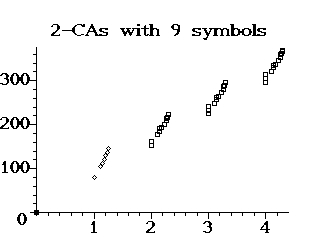| k | N | Source |
| 10 | 81 | orthogonal array |
| 13 | 105 | group 1-rotational (Meagher-Stevens, Colbourn) |
| 14 | 113 | group 1-rotational (Meagher-Stevens, Colbourn) |
| 15 | 121 | group 1-rotational (Meagher-Stevens, Colbourn) |
| 16 | 129 | group 1-rotational (Meagher-Stevens, Colbourn) |
| 17 | 137 | group 1-rotational (Meagher-Stevens, Colbourn) |
| 18 | 145 | group 1-rotational (Meagher-Stevens, Colbourn) |
| 99 | 153 | CMMSSY 2.3 |
| 100 | 161 | CMMSSY 2.3 |
| 129 | 177 | CMMSSY 2.3 |
| 139 | 185 | CMMSSY 2.3 |
| 140 | 191 | CMMSSY 2.2 |
| 149 | 193 | CMMSSY 2.3 |
| 168 | 201 | CMMSSY 2.2 |
| 181 | 209 | CMMSSY 2.2 |
| 182 | 215 | CMMSSY 2.2 |
| 195 | 217 | CMMSSY 2.2 |
| 196 | 223 | CMMSSY 2.2 |
| 981 | 225 | CMMSSY 2.3 |
| 990 | 233 | CMMSSY 2.3 |
| 1000 | 241 | CMMSSY 2.3 |
| 1278 | 249 | CMMSSY 2.3 |
| 1377 | 257 | CMMSSY 2.3 |
| 1400 | 263 | CMMSSY 2.3 |
| 1476 | 265 | CMMSSY 2.3 |
| 1665 | 273 | CMMSSY 2.2 |
| 1794 | 281 | CMMSSY 2.2 |
| 1820 | 287 | CMMSSY 2.2 |
| 1933 | 289 | CMMSSY 2.2 |
| 1960 | 295 | CMMSSY 2.2 |
| 9720 | 297 | CMMSSY 2.3 |
| 9810 | 305 | CMMSSY 2.3 |
| 9900 | 313 | CMMSSY 2.3 |
| 12663 | 321 | CMMSSY 2.3 |
| 13644 | 329 | CMMSSY 2.3 |
| 13860 | 335 | CMMSSY 2.3 |
| 14625 | 337 | CMMSSY 2.3 |
| 16497 | 345 | CMMSSY 2.2 |
| 17775 | 353 | CMMSSY 2.2 |
| 18060 | 359 | CMMSSY 2.2 |
| 19152 | 361 | CMMSSY 2.2 |
| 19460 | 367 | CMMSSY 2.2 |
| 20000 | 369 | CMMSSY 2.3 |
| | Graph:
 |
